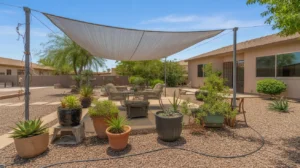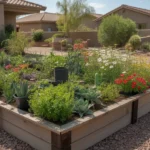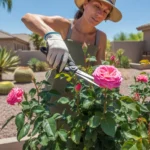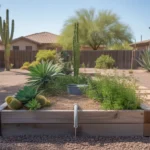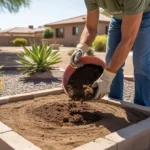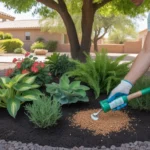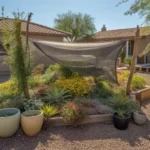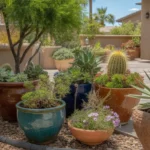Container plants add color and life to Southeast Valley yards, but intense summer heatwaves can quickly take their toll. With a little extra TLC, you can help your potted plants not just survive but thrive through the scorching temperatures. These expert tips will keep your container gardens looking lush all season long.
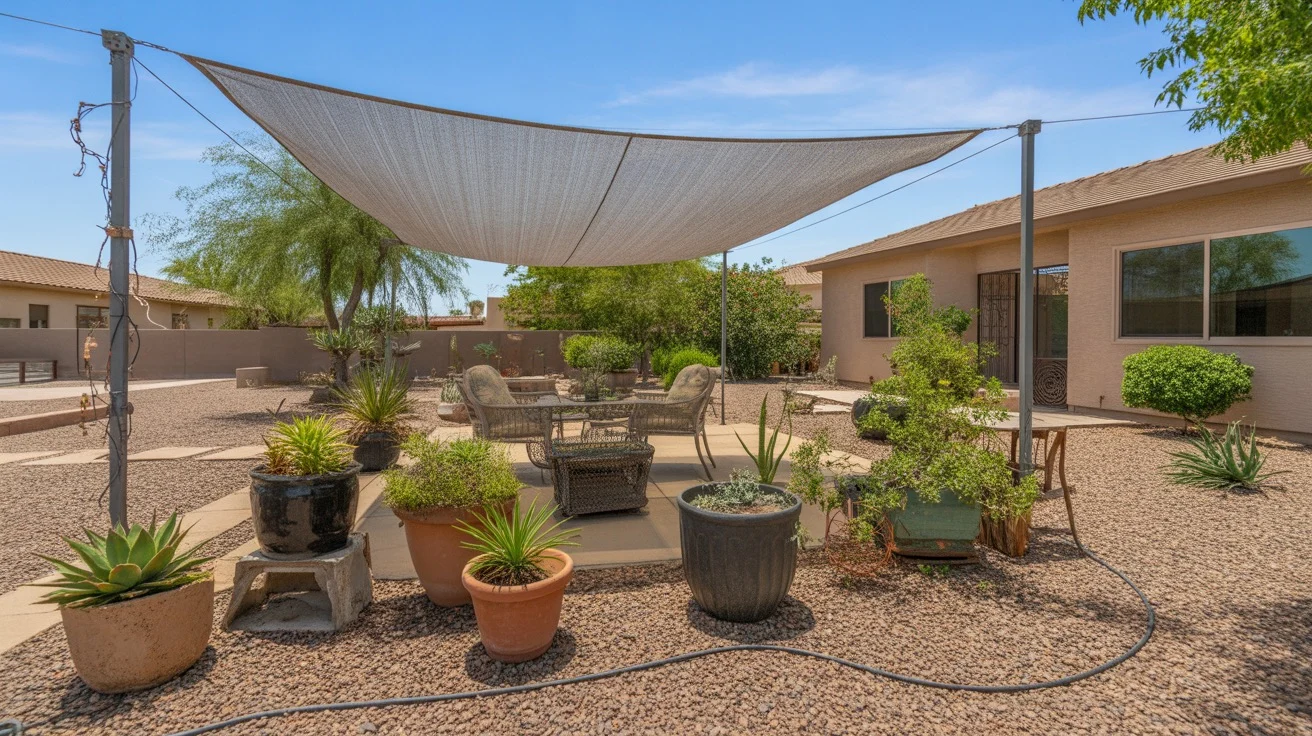
Water Deeply and Consistently
Proper watering is critical for container plants during a heatwave. The confined space and limited soil volume make pots prone to drying out much faster than in-ground beds. Check soil moisture daily by sticking your finger about an inch deep. If it feels dry, it’s time to water.
When you do water, do so thoroughly until liquid flows from the drainage holes. This ensures the entire root zone gets moistened. Avoid frequent shallow watering, which only dampens the surface while leaving roots parched. Early morning is the best time to water so plants can hydrate before the intense midday heat.
If you’ll be away during hot spells, consider installing a simple drip system on a timer to keep your containers consistently watered. Grouping pots together also helps them shade each other and reduces evaporation. For an extra boost, use a water-soluble fertilizer every couple weeks to replenish nutrients that get flushed out with frequent watering.
Provide Shade During Peak Heat
Even sun-loving plants can get scorched under the relentless Southeast Valley summer sun. Providing some shade during the hottest part of the day can make a big difference in plant health. Position containers where they get morning sun but are shielded from harsh afternoon rays, such as on an east-facing patio or under a tree canopy.
You can also use shade cloth or screens to filter the light. Drape shade fabric over hoops or a frame to create a protective tent for vulnerable plants. Look for material that provides 30-50% shade, which is enough to reduce stress while still allowing sufficient light for growth.
Another option is to temporarily move containers to a shadier spot during extreme heat. Placing them under an overhang, covered porch, or patio umbrella can provide respite on the hottest days. Just be sure to move sun-lovers back into brighter light once the heatwave subsides to prevent them from getting leggy.
Mulch to Conserve Moisture
Mulching is one of the easiest ways to help container plants withstand high temperatures. A layer of organic mulch like shredded bark, straw, or coco coir on the soil surface insulates roots, reduces evaporation, and moderates soil temperature fluctuations. Apply a 1-2 inch layer, keeping it away from plant stems to prevent rot.
As the mulch breaks down, it also adds nutrients and improves soil structure. For an attractive, desert-friendly look, try using pebbles or crushed rock as a decorative mulch top-dressing. Just be sure to include a moisture-holding layer underneath, such as coco fiber, to get the full protective benefits.
Mulch is especially crucial for hanging baskets and small containers, which are even more vulnerable to drying out and heat stress. A thick layer will act like a mini shade umbrella for the soil and keep roots cooler. Refresh the mulch periodically throughout the season as it decomposes or blows away.
Choose Heat-Adapted Plants
When selecting plants for containers, lean towards varieties well-adapted to the Southeast Valley’s intense heat. Native desert perennials like penstemon, desert marigold, and blackfoot daisy are naturally resilient to high temperatures and drought. Succulents such as agave, yucca, and sedum store water in their fleshy leaves, making them excellent low-maintenance choices.
For a lush look, try sun-loving tropical plants that thrive in hot, humid conditions. Hibiscus, mandevilla vine, and elephant ear all have bold foliage and bright blooms that add a resort-like feel. Herbs like rosemary, thyme, and oregano have small leaves and tolerate dry soil, perfect for a patio kitchen garden.
When in doubt, check plant labels for heat and sun tolerance. Look for descriptors like “thrives in full sun,” “drought tolerant,” or “heat loving.” Annuals like zinnia, moss rose, and gaillardia are also reliable choices that bloom nonstop even in blistering weather. By sticking with tough, adaptable plants, you’ll set your containers up for success no matter how high the mercury rises.
Adjust Fertilizing and Pruning
Container plants’ needs change during extreme heat, and adjusting your maintenance routine can help minimize stress. Avoid fertilizing during a heatwave, as this encourages new growth that is more vulnerable to damage. Wait until temperatures drop back into the normal range before resuming a regular feeding schedule.
Similarly, limit pruning to just removing dead or diseased foliage. Cutting plants back stimulates tender new leaves that can get scorched. Save major pruning for cooler weather in fall or early spring. The exception is deadheading spent flowers, which helps direct energy into healthy growth and new blooms.
If a plant does get sunburned, don’t panic. Trim off crispy leaves or stems and provide extra shade until it recovers. A stressed plant may shed foliage to conserve resources, but will usually bounce back with consistent care. Just like people, plants need a little extra pampering to look their best during a heatwave.
Watch for Warning Signs
Catching heat stress early gives you the best chance of saving a struggling plant. Wilting is often the first red flag, indicating a plant is losing moisture faster than it can take up. Crispy brown leaf edges, yellowing, and leaf drop are other signs a plant is overheating.
Check containers at least once a day during hot spells. Feel the soil, look under leaves, and pay attention to changes in plant appearance. If you spot any concerning symptoms, take action right away. Move the plant to shade, give it a deep drink, and mist the foliage to increase humidity.
Some problems like sunburn are irreversible once they occur, so prevention is key. Keeping plants well-watered, protected from midday sun, and sheltered from hot wind will go a long way in preventing heat damage. With a watchful eye and a little extra care, you can keep your container plants healthy and vibrant all summer long.

